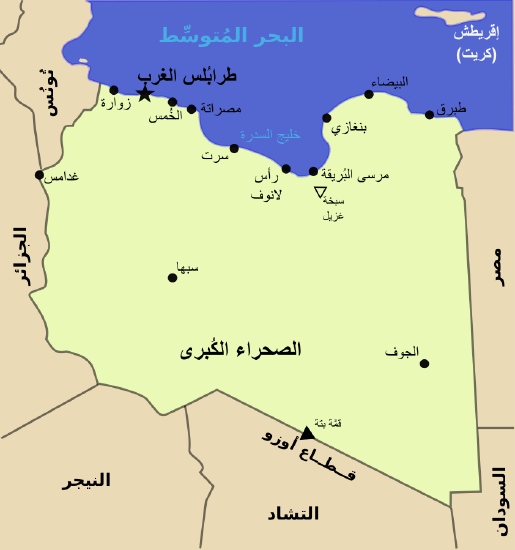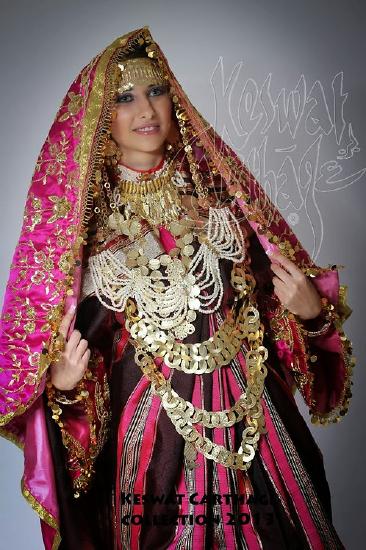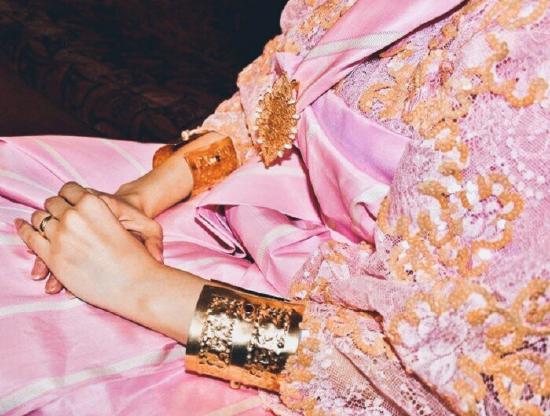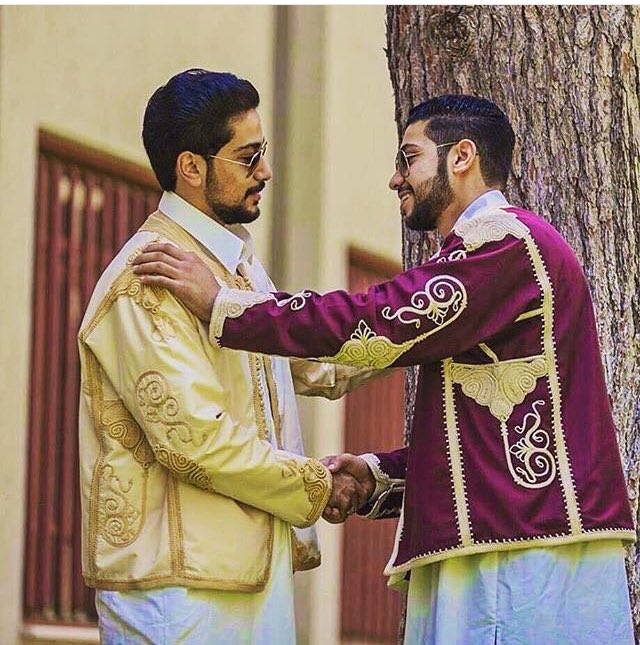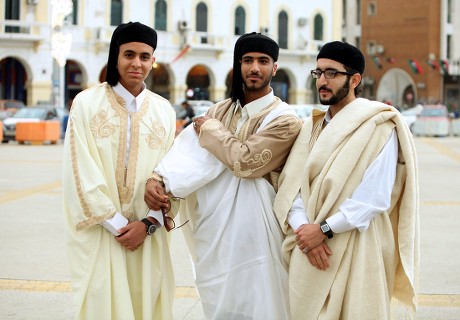10.9: Libya
- Page ID
- 251272
\( \newcommand{\vecs}[1]{\overset { \scriptstyle \rightharpoonup} {\mathbf{#1}} } \)
\( \newcommand{\vecd}[1]{\overset{-\!-\!\rightharpoonup}{\vphantom{a}\smash {#1}}} \)
\( \newcommand{\dsum}{\displaystyle\sum\limits} \)
\( \newcommand{\dint}{\displaystyle\int\limits} \)
\( \newcommand{\dlim}{\displaystyle\lim\limits} \)
\( \newcommand{\id}{\mathrm{id}}\) \( \newcommand{\Span}{\mathrm{span}}\)
( \newcommand{\kernel}{\mathrm{null}\,}\) \( \newcommand{\range}{\mathrm{range}\,}\)
\( \newcommand{\RealPart}{\mathrm{Re}}\) \( \newcommand{\ImaginaryPart}{\mathrm{Im}}\)
\( \newcommand{\Argument}{\mathrm{Arg}}\) \( \newcommand{\norm}[1]{\| #1 \|}\)
\( \newcommand{\inner}[2]{\langle #1, #2 \rangle}\)
\( \newcommand{\Span}{\mathrm{span}}\)
\( \newcommand{\id}{\mathrm{id}}\)
\( \newcommand{\Span}{\mathrm{span}}\)
\( \newcommand{\kernel}{\mathrm{null}\,}\)
\( \newcommand{\range}{\mathrm{range}\,}\)
\( \newcommand{\RealPart}{\mathrm{Re}}\)
\( \newcommand{\ImaginaryPart}{\mathrm{Im}}\)
\( \newcommand{\Argument}{\mathrm{Arg}}\)
\( \newcommand{\norm}[1]{\| #1 \|}\)
\( \newcommand{\inner}[2]{\langle #1, #2 \rangle}\)
\( \newcommand{\Span}{\mathrm{span}}\) \( \newcommand{\AA}{\unicode[.8,0]{x212B}}\)
\( \newcommand{\vectorA}[1]{\vec{#1}} % arrow\)
\( \newcommand{\vectorAt}[1]{\vec{\text{#1}}} % arrow\)
\( \newcommand{\vectorB}[1]{\overset { \scriptstyle \rightharpoonup} {\mathbf{#1}} } \)
\( \newcommand{\vectorC}[1]{\textbf{#1}} \)
\( \newcommand{\vectorD}[1]{\overrightarrow{#1}} \)
\( \newcommand{\vectorDt}[1]{\overrightarrow{\text{#1}}} \)
\( \newcommand{\vectE}[1]{\overset{-\!-\!\rightharpoonup}{\vphantom{a}\smash{\mathbf {#1}}}} \)
\( \newcommand{\vecs}[1]{\overset { \scriptstyle \rightharpoonup} {\mathbf{#1}} } \)
\( \newcommand{\vecd}[1]{\overset{-\!-\!\rightharpoonup}{\vphantom{a}\smash {#1}}} \)
\(\newcommand{\avec}{\mathbf a}\) \(\newcommand{\bvec}{\mathbf b}\) \(\newcommand{\cvec}{\mathbf c}\) \(\newcommand{\dvec}{\mathbf d}\) \(\newcommand{\dtil}{\widetilde{\mathbf d}}\) \(\newcommand{\evec}{\mathbf e}\) \(\newcommand{\fvec}{\mathbf f}\) \(\newcommand{\nvec}{\mathbf n}\) \(\newcommand{\pvec}{\mathbf p}\) \(\newcommand{\qvec}{\mathbf q}\) \(\newcommand{\svec}{\mathbf s}\) \(\newcommand{\tvec}{\mathbf t}\) \(\newcommand{\uvec}{\mathbf u}\) \(\newcommand{\vvec}{\mathbf v}\) \(\newcommand{\wvec}{\mathbf w}\) \(\newcommand{\xvec}{\mathbf x}\) \(\newcommand{\yvec}{\mathbf y}\) \(\newcommand{\zvec}{\mathbf z}\) \(\newcommand{\rvec}{\mathbf r}\) \(\newcommand{\mvec}{\mathbf m}\) \(\newcommand{\zerovec}{\mathbf 0}\) \(\newcommand{\onevec}{\mathbf 1}\) \(\newcommand{\real}{\mathbb R}\) \(\newcommand{\twovec}[2]{\left[\begin{array}{r}#1 \\ #2 \end{array}\right]}\) \(\newcommand{\ctwovec}[2]{\left[\begin{array}{c}#1 \\ #2 \end{array}\right]}\) \(\newcommand{\threevec}[3]{\left[\begin{array}{r}#1 \\ #2 \\ #3 \end{array}\right]}\) \(\newcommand{\cthreevec}[3]{\left[\begin{array}{c}#1 \\ #2 \\ #3 \end{array}\right]}\) \(\newcommand{\fourvec}[4]{\left[\begin{array}{r}#1 \\ #2 \\ #3 \\ #4 \end{array}\right]}\) \(\newcommand{\cfourvec}[4]{\left[\begin{array}{c}#1 \\ #2 \\ #3 \\ #4 \end{array}\right]}\) \(\newcommand{\fivevec}[5]{\left[\begin{array}{r}#1 \\ #2 \\ #3 \\ #4 \\ #5 \\ \end{array}\right]}\) \(\newcommand{\cfivevec}[5]{\left[\begin{array}{c}#1 \\ #2 \\ #3 \\ #4 \\ #5 \\ \end{array}\right]}\) \(\newcommand{\mattwo}[4]{\left[\begin{array}{rr}#1 \amp #2 \\ #3 \amp #4 \\ \end{array}\right]}\) \(\newcommand{\laspan}[1]{\text{Span}\{#1\}}\) \(\newcommand{\bcal}{\cal B}\) \(\newcommand{\ccal}{\cal C}\) \(\newcommand{\scal}{\cal S}\) \(\newcommand{\wcal}{\cal W}\) \(\newcommand{\ecal}{\cal E}\) \(\newcommand{\coords}[2]{\left\{#1\right\}_{#2}}\) \(\newcommand{\gray}[1]{\color{gray}{#1}}\) \(\newcommand{\lgray}[1]{\color{lightgray}{#1}}\) \(\newcommand{\rank}{\operatorname{rank}}\) \(\newcommand{\row}{\text{Row}}\) \(\newcommand{\col}{\text{Col}}\) \(\renewcommand{\row}{\text{Row}}\) \(\newcommand{\nul}{\text{Nul}}\) \(\newcommand{\var}{\text{Var}}\) \(\newcommand{\corr}{\text{corr}}\) \(\newcommand{\len}[1]{\left|#1\right|}\) \(\newcommand{\bbar}{\overline{\bvec}}\) \(\newcommand{\bhat}{\widehat{\bvec}}\) \(\newcommand{\bperp}{\bvec^\perp}\) \(\newcommand{\xhat}{\widehat{\xvec}}\) \(\newcommand{\vhat}{\widehat{\vvec}}\) \(\newcommand{\uhat}{\widehat{\uvec}}\) \(\newcommand{\what}{\widehat{\wvec}}\) \(\newcommand{\Sighat}{\widehat{\Sigma}}\) \(\newcommand{\lt}{<}\) \(\newcommand{\gt}{>}\) \(\newcommand{\amp}{&}\) \(\definecolor{fillinmathshade}{gray}{0.9}\)In this section, you will be able to:
- Learn about Libya, its Geographical location, its famous cities, its most famous artifacts, its traditional food, and clothes
Libya ليبيا

Facts to know about Libya
- Official Name: The state of Libya- دولة ليبيا
- Capital: Tripoli- طرابلس
- Population: 7,086,921 (2022)
- Currency:Libyan Dinar- دينار ليبي
- Continent: Africa- أفريقيا
- Official Lagrange: Modern Standard Arabic- اللغة العربية الفصحى
1.1 Geographical Location & Flag
- Libya is a country located in North Africa.
- It is the fourth largest country in Africa and the Arab World.
- The capital is Tripoli, and the largest city.
- It's bordered by Egypt on the east, Algeria to the west, the Mediterranean Sea to the north, Chad to the south, and Sudan to the southeast.
- Libya has the tenth-largest oil reserves in the world.
- It has about three million people out of the seven million Arabs and Berbers.
- Most of Libyan region lies in the Sahara desert, and most of the population live in Tripoli, Benghazi, and other cities along the coast.
- Libya is well known for its ancient Roman and Greek ruins and Sahara desert beautiful landscapes.
- Libya has along and rich history, with influences from a variety of cultures, including Arab, African, and European.
1.2 Most Famous Cities
There are many major cities in Libya. Some of them are Tripoli, Benghazi, Misrata, Al Bayda, Ghat, Sirte, Ghadames, Sabratah, Sabha
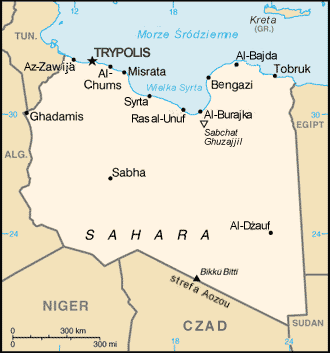
| City Name | City Name in Arabic | Pronunciation | Image |
|---|---|---|---|
| Tripoli | طرابلس | tarabulus |
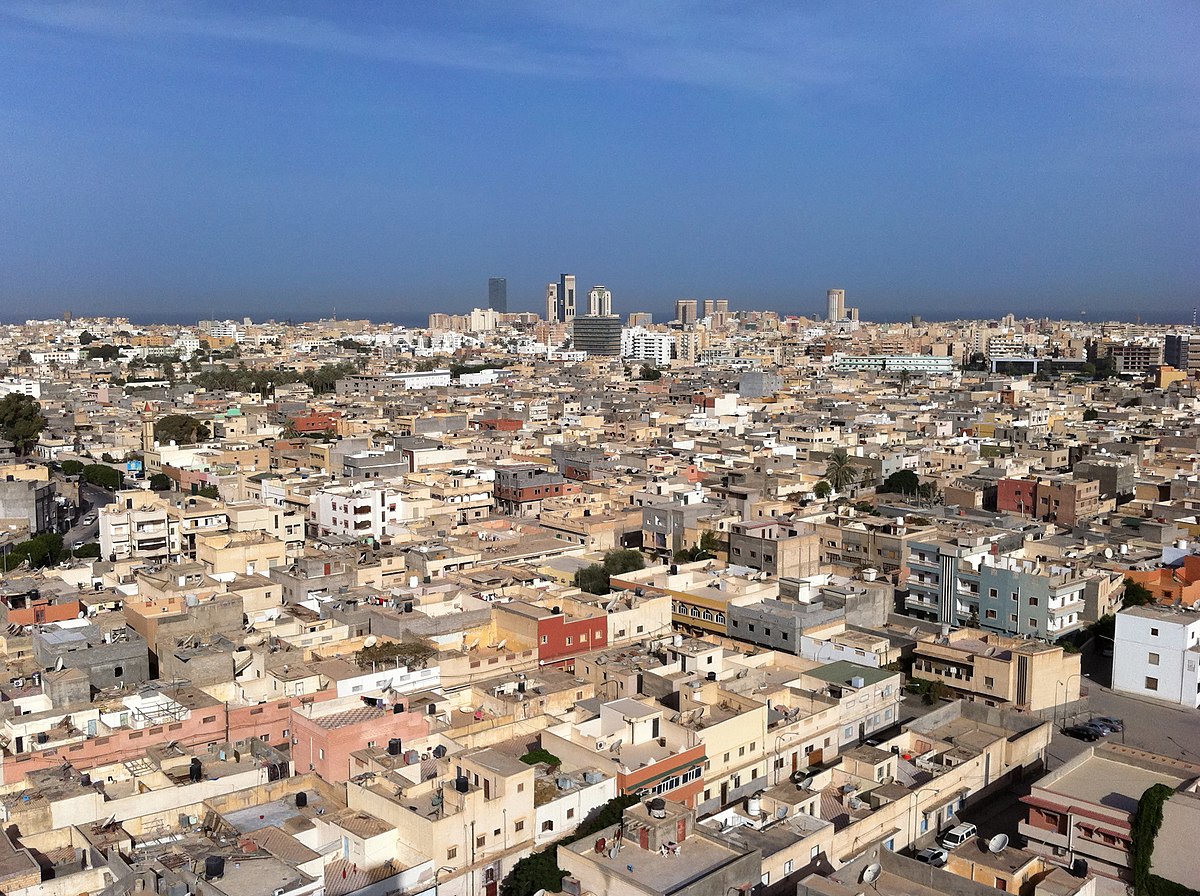
|
| Benghazi | بنغازي | banghazi |

|
| Misrata | مصراتة | misrata |

|
| Al Bayda | البيضاء | albayda' |
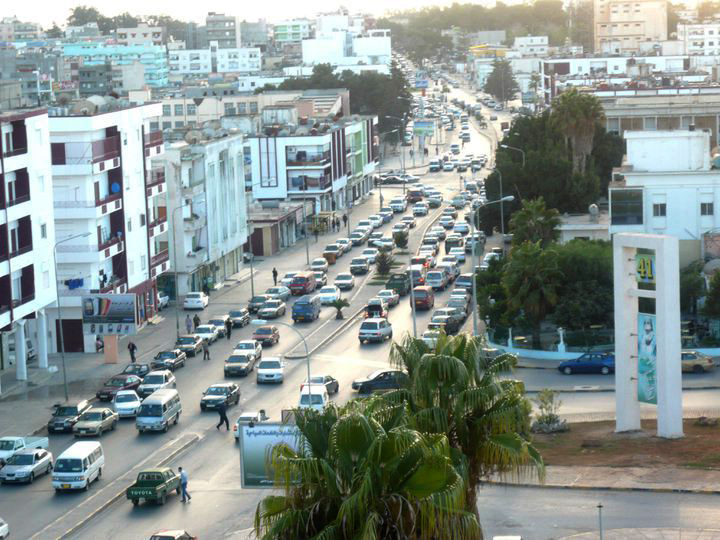
|
| Sirte | سرت | sirat |
|
| Sabratah | صبراتة | sabrata |
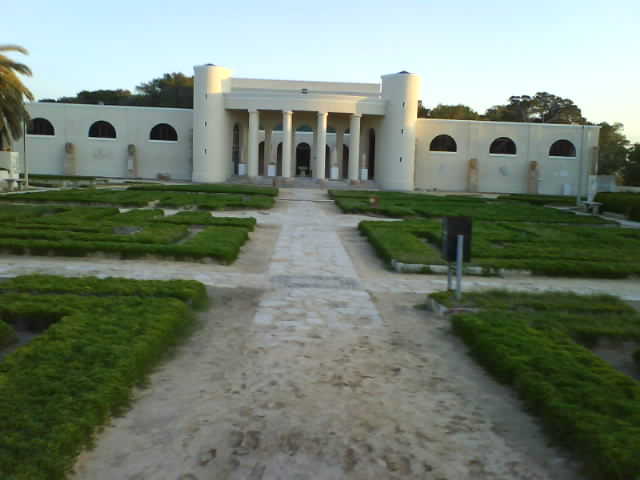
|
| Sabha | سبها | subuha |
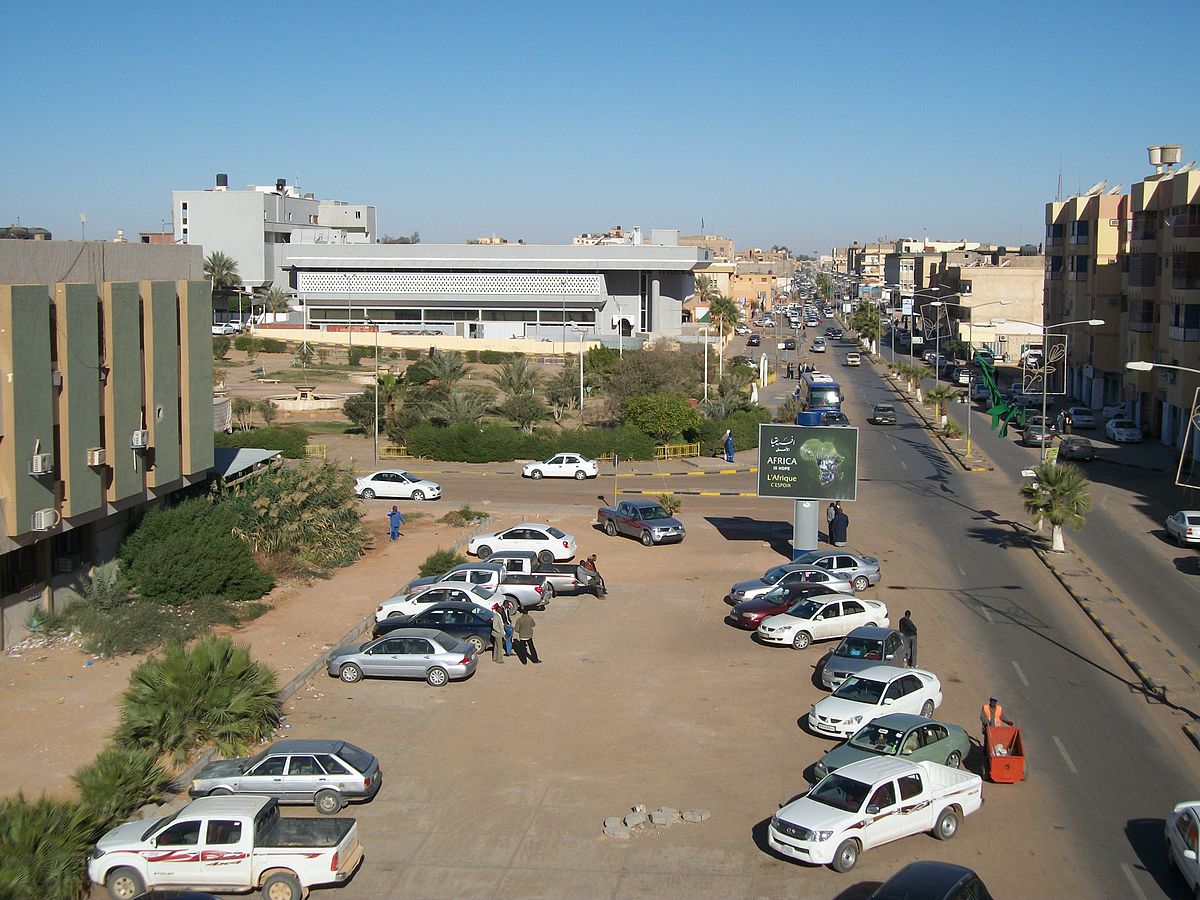
|
1.3 Most famous artifacts
Tripoli Red Castle- Assai- Al- Hamra
The Tripoli Red Castle, as known as the Assai Al Hamra, is one of the major landmarks in the city Tripoli in Libya. It was built in 9th century by the Aghlabids, a Muslim dynasty that ruled over parts of North Africa and Sicily. It is called red because most of its parts are painted in red color. it is located in the northeastern of the city of Tripoli and overlooks Omar Al-Mukhtar and Al Fatah streets. It was built on the remains of Roman buildings, or temples. it was built to defend the city from outsiders. the castle is a popular attraction and is considered a symbol of the city's rich history.

Ghadames City
Ghadmaes city is called " the pearl of the desert" for its outstanding architectural design. It is one of the oldest and most notable Saharan cities in the Arab world. It has been the shining role and peaceful center in the cultural and economic life of the region. It was occupied by many people, including Phazaniis, Romans, Byzantines, Christianity, Islamic conquests, Ottoman empires, and the European occupation in the 19th century and during the colonial period and World War ll.

Leptis Magna
Leptis Magna was the largest city of the ancient region of Tripolitania, located on the North African coast of the Mediterranean Sea in present Libya. It was a Phoenician city and one of the most attractive cities of the Roman Empire, with its magnificent public monuments, harbors, marketplace, stores, and suburban regions.
_(8288918733).jpg?revision=1&size=bestfit&width=609&height=406)
Ptolemais
Ptolemais is an ancient city located along the Mediterranean coast of Libya. It is considered one of the five most important cities that established Pentaploi. it represents the distinctive regional cultural traditions created by diverse ethnicities and cultures that made up the region's social fabric, particularly Greek, Egyptian, Roman, Libyan, Byzantine, and Islamic. It is a little jewel of a historical spot and an important port in Libya. Its ancient remains and ruins are in modern Libya called Tolmeita.

Roman Sabratha
Sabratha was one of the major ports of Roman Tripoli that had a strong business connection with North Africa. Originally, it was a Phoenician settlement. Then the Roman enlarged the city by building streets, commercial, temples, and administrative. Most notable features of Sabratha include: The theater, the forum, the temples, and the city baths.

1.4 Traditional Food & Clothing in Libya
Most Popular Food in Libya
| Food in English | Food in Arabic | Ingredients | Image |
|---|---|---|---|
| Couscous bil-bosla | كسكس بالبصل |
|
|
| makaruna imbaukha | مكرونة مبوخة |
|
|
| Shakshouka | شكشوك |
|
|
| Hasa adas | حساء عدس |

|
|
| Kufta bil batinjal | كفتة بالباذنجان |
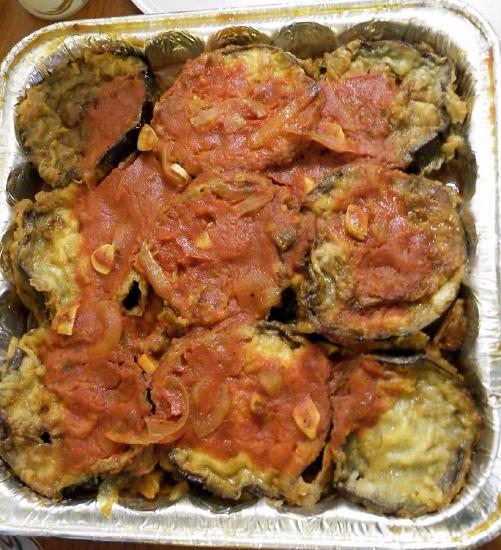
|
|
| Basbousa | بسبوسة |

|
|
| Bazin | البازين |
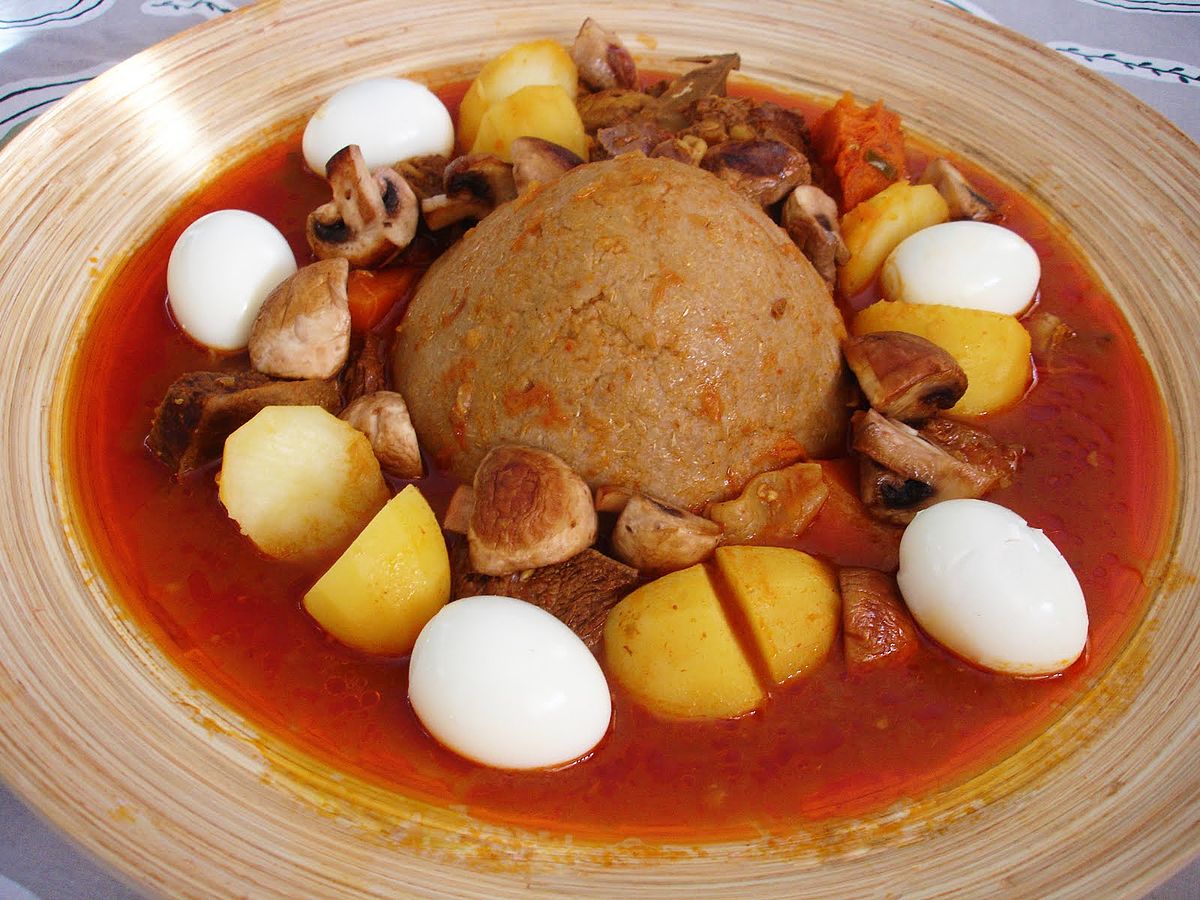
|
|
| Sfinz | سفنز |
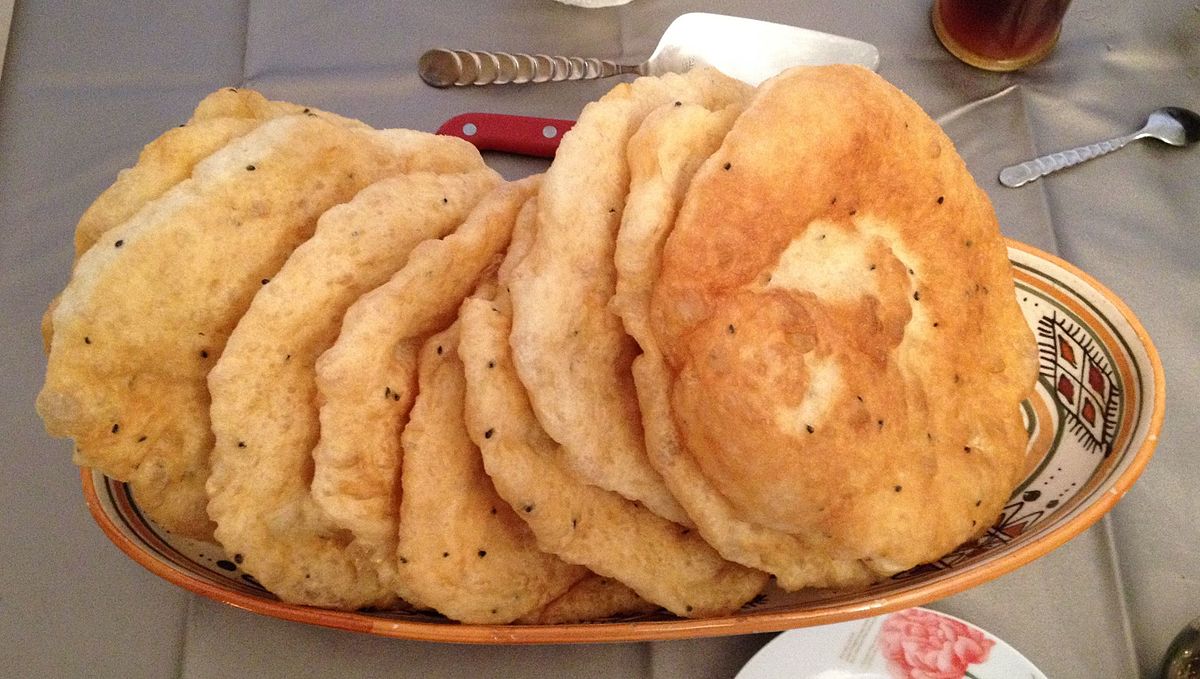
|
Most Popular Clothing in Libya
In Modern days, Libyan people dress in different ways. in the urban ares, Libyans wear western clothing such as jeans and shirts, but on the special occasions, they wear their traditional clothes.
Women Traditional Dress
- Traditional Libyan women's clothing varies depending on the region, and the occasion.
- Some women wear bright colors like togas clothe with a blouse with loose sleeves, embroidered with beads, and silver/gold yaren with silk trousers closed at the ankle.
- The head is covered by a colorful cloth decorated with beads.
- The bridal dress for Libyan women is called hasira which is made of white silk, and embroidered with silver and gold thread. Also, they wear heavy neck golden pieces that reach to the knees, and gold cuffs adorn the wrists.
- Henna Day is essential before the wedding, where women from the community will be invited and gathered to have henna designs along with the bride.
- Traditional Libyan women's clothing is designed to be modest and conservative, while also showcasing the beauty and craftsmanship of the local culture.
Men Traditional Cloth
- Libyan men prefer to wear their traditional costumes on special occasions such as Friday prayers, wedding ceremonies, holidays, and Ramadan.
- Traditional men's clothing are long "tunic" and long pants- "sirwal" and vest "sadriyia" is made from black silk and fastened at the front with buttons. The thobe, a long loose fitting garment with full sleeves and a collar, the bisht, a long flowing cloak made from wool or camel hair, the agal, a type of headband or bandana worn around the head to hold the ghutrah in place.
- Libyan men prefer to wear their traditional costumes on special occasions such as Friday prayers, wedding ceremonies, holidays, and Ramadan.
You traveled to Libya. And you went to a restaurant to eat. Share with your friends on your Instagram page the name of the restaurant and the food you ordered, and describe the restaurant and food. For example, beautiful, clean, delicious, and tasty.




